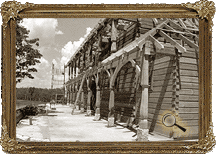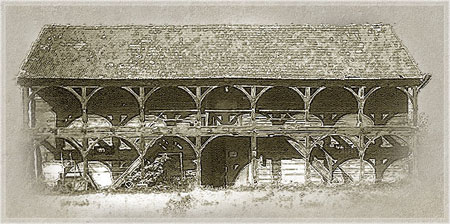The larch granary comes from Borowno village in Mykanów district where it was erected in 1783 on Franciszek Paciorkowski's request. The granary is an example of an old Polish, wooden folk architecture.
LOCATION
At first it was located in the manor next to the service buildings which do not exist at the moment because they were destroyed after the World War II. This area is now used by the Local Agricultural Community in Mykanów in a former Reszke family's estate, next to the newly created warehouse buildings.
BUILDING
The date of the building erection is carved on the door frame of the passage from the hall to the room on the left (which is now called the Green Room), whereas the name and surname of the founder is on the external part of the entrance door frame on the west side (from the terrace part which used to be there). The object was composed of the 18th century construction which is very rare in the architecture and has two floors decorated with archways and a gabled roof covered with ceramic tiles made most probably in 1945. There were three rooms in the lower part of the granary in the plan similar to the present one. The upper part had no divisions. Windows were located in two areas in the form of lying rectangles. The building has one of the longest beams in Poland and the longest beam which has ever been used in wooden construction, handmade out of one part of the trunk of the length equal to 19.60 supporting the whole object on the second floor.


CONSTRUCTION DATA
The building has a usable attic and it was built on the projection of a rectangle with two-floor seven-span archways (porches) along two long walls from the outside. On the lower floor in the building axis there is a drive-hall which people used to enter going up three steps, whilst people entered the rooms on the left and right side by means of a dividing beam. The room on the upper floor was accessed by means of stairs through the upper porch from the east side. The attic can be accessed by internal steps from the upper floor. The hall is enclosed from both sides by a double-leaf door with swords supporting lintels. The leaves are strengthened by bolts and are opened on a vertical extreme element located in a stone gap and fastened up with an iron clamp. The remaining doors are of simple construction (revel and lintel), door-leaves with horizontal bolts on hinges in a blacksmith style.

HISTORY
Later the object was a part of a court complex of world-famous opera singers - the Reszke family who came back to Poland when they finished their artistic carrier and they settled near Częstochowa. John, Edward and Josephine were famous and achieved a spectacular financial success and this is why they had an opportunity to buy the properties near their sister who settled in Borowina. The tomb of one of the siblings - Edward Reszke, the first tenor in Europe and the USA - is located in this village. Political changes were responsible for the collapse of the estate. In 1945 a decree about the estate nationalisation was read. In 1996 the wooden object was demolished and continued to decay. Its new history was started in 2007 when it was moved to Olsztyn and reconstructed in an original character at the foot of a fourteenth-century Olsztyn Castle. The building was well-preserved and this is why it is authentic to a large extent. It can be estimated that its appearance from the year 1783 has been reconstructed in 90%. The object has been entered in the "0" class monuments’ register and it is one of the most valuable old Polish wooden buildings of folk architecture in the area of Jura Krakowsko-Częstochowska (the Kraków-Częstochowa Upland). In 2008 the granary became a laureate in the "Zadbany Zabytek A.D. 2008" Competition (the Well-Cared For Monument A.D. 2008 Competition) organised by the General Conservator-Restorer in 2008. The owners were awarded the Laureate’s Diploma in the same competition for the reconstruction of a wooden court granary in a new place and its adaptation to new functions.
